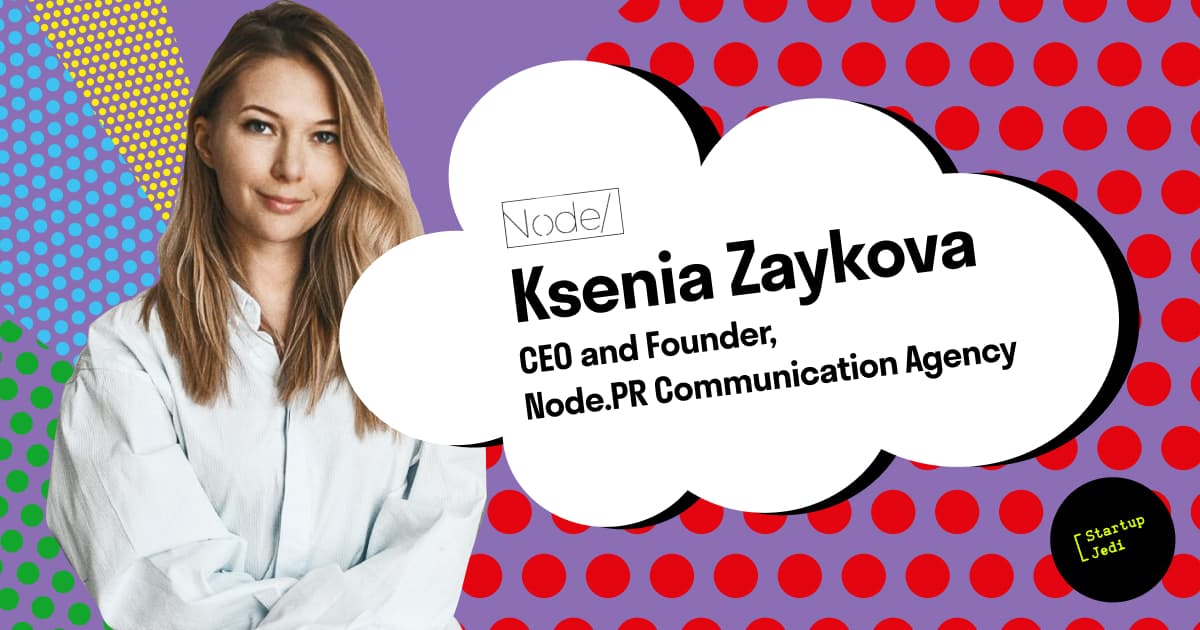
Startup Jedi
We talk to startups and investors, you get the value.
Ksenia Zaykova, founder of the NODE PR communication agency will tell you what a startup should focus on when developing a PR strategy and which media to choose.

Startup Jedi
We talk to startups and investors, you get the value.
When developing a PR strategy, you need to firstly take into account the goal that a startup sets for itself. This will directly affect the choice of channels and priority media.
Possible goals include:
Raising investments;
Increased visibility and, as a result, reduced marketing costs due to gaining visibility and waiving the main objections.

If your goal is to raise investment, image business media with large coverage will become a logical choice. In the CIS, for example, these are RBC, Forbes, Vedomosti, Kommersant, InVenture, AIN.UA, VECTOR, etc. However, do not forget the media that venture capital market specialists read, like VC.ru, Rusbase, Startup Jedi. In terms of choosing publication formats, preference should be given to those that show the relevance of your solution in the medium and long term. These include market reviews, as well as cases where you can demonstrate how you managed to solve some “pain” of the market and what opportunities for further development you see.
If you are working on brand awareness and confidence in your product in order to further reduce marketing costs, the media that specialize in one industry (specializing in your specific field of activity) will be your first priority. And only then, with the development of primary publicity, one should go to the media with greater coverage, but with a more diffuse audience. In terms of formats, in this case we recommend to give preference to cases and expert columns.
Don’t forget about press releases and comments. Both increase the recognition of the speaker and the company when used correctly, and have a potentially high viral effect.
Let’s take a closer look at each format.
...

This is one of the most common formats in the business environment. In the classical version, this is the material that leads the reader from point A to point B (before-after). It can be a story of starting a business, developing a product, running a separate project, etc.
The case always shows and describes the main problem in detail (in the case of a separate project, it sets a task), and then describes the entire path to its solution. Such materials often describe the difficulties that appear at different stages of the project in detail, show how the company overcomes them and what indicators the business eventually arrives at. The results, expressed in specific figures, are one of the key differences of the case from other texts.
The format of the case is convenient in that it can highlight the company’s advantages and include information about its products, as well as demonstrate its viability and investment attractiveness. However, it should be presented as non-advertising as possible — without phrases like “the best product on the market”, “one of a kind”, “will solve all your problems”, etc.
The audience always appreciates sincerity in cases: if an entrepreneur does not hesitate to openly admit mistakes, confidence in them increases, and the material becomes more interesting to read. The founder of the clothing company Barssport, Emil Sirazev, described the reasons and history of creating his own ERP system for automating business processes in one of the cases. In the same article, he openly stated that the reason he created it in the first place was that he’d lost 500,000 rubles when due to a mistake in choosing a contractor, the company had to alter 6,500 T-shirts at its own expense. The case collected almost 12 thousand views and was actively discussed in the comments. And yes, Emil did not have to pay a single ruble for posting this material: the editors of a large business portal published it without mentioning it’s a “Partner material”.
Where to publish: high-quality material that shows how to solve a specific business problem will be of interest to both large and trade media. When describing a separate project (for example, a marketing case), it is more appropriate to send the text to the trade magazine.
...

This text is typically written on behalf of the startup founder. The key tasks that such materials aim at are informing the audience about the speaker and their expertise in a particular area (note that for startups planning to go abroad, it is the expert columns that can help with obtaining a visa).
In expert materials, the speaker must demonstrate deep knowledge in their area of specialization. They analyze the causes of problems and suggest their possible solutions, making forecasts about the development of the market in the future. As with any native posting, utility is key here, so it’s important to refrain from advertising. For example, in an article by Sergei Voinov, the CEO of EveryTag (a company in the field of information security), they consistently talk about trends in the information security market for 20 years through the speaker’s career path. At the same time, there is minimal self-advertising in the text, and they even managed to successfully integrate the presentation of the company’s product into one of the paragraphs.
Where to publish: both trade media and general media work for this.
...

When a speaker reaches a certain level of publicity, they may be invited to act as an expert for a review article or write it themselves. The main requirement is to really be well versed in the problems described.
The situation at the very beginning of the pandemic in 2020 was indicative. It was then that many industries turned to the state for help, but few used their publicity capital. Nevertheless, this was done by the auto repair industry and the network of smart car services “Vilgud”, which in an open letter requested support from the Russian Government. In their appeal, they drew attention to the fact that more than half of market players may be unemployed if quarantine measures are in effect for a long time. As a result, the co-founder of Vilgood received an offer from Forbes to compile a detailed article on the state of the auto repair market.
The main advantage of the review is neutrality and an objective presentation of facts. In our experience, it is these materials that work well to draw attention to a grave problem.
Where to publish: both large and trade media publish reviews.
...

While many think press release is a dying format, it is actually not. The problem often is that companies are not able to assess the importance of a particular news hook. So when they get rejected for publication, they tend to conclude it “doesn’t work.”
In the case of startups, really significant news hooks can be raising investments, going abroad, partnering up with a larger company, and the launch itself (but with the right presentation).
Thus, G-71, the company with Russian roots entered the US market in July 2020. The press release about the launch was presented in terms of solving the main pain that is a security flow in information security systems from insiders. As a result, the release garnered over 3,000 views and was published by major media outlets in the information security industry, as well as by giants like Yahoo Finance.
Where to publish. It depends on what news hook you write about. Information about making a deal with a major partner may be of interest to RBC and Forbes, but news about changes within a little-known startup can be sent, at most, to the specialized magazine.
...

Another great way to build visibility is to comment on your industry topic. Despite the fact that comments rarely occupy more than 5–10% of the main material, they are often actively viralized due to an interesting news feed. Thus, with their help, sometimes even greater coverage can be obtained than with the publication of individual materials.
This method is great for startups that are just building awareness. Besides, there are a number of services, such as Pressfeed or Haro, which can be used to connect with journalists and editors of targeted publications. Media representatives themselves leave requests and look for experts on relevant topics on these platforms. The task of startups is to track them and respond promptly. At a certain level of recognition, the need to use such services decreases: journalists come to popular and interesting speakers for comments directly.
Thus, when choosing a media and a format for materials, startups should mainly be guided by the long-term PR goals. Any text should contain only useful information with minimal advertising content so that you don’t have to pay for the publication.
Facebook: facebook.com/StartupJedi/
Telegram: t.me/Startup_Jedi
Twitter: twitter.com/startup_jedi
Comments